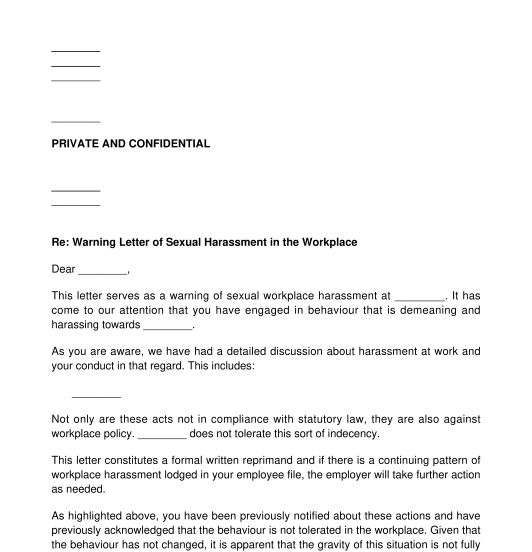 26/10/2025
26/10/2025

Answer a few questions and your document is created automatically.

Your document is ready! You will receive it in Word and PDF formats. You will be able to modify it.

 26/10/2025
26/10/2025
 Word and PDF
Word and PDF
 1 to 2 pages
1 to 2 pages
A Warning Letter of Workplace Harassment notifies an employee that harassment has taken place in the workplace. An employer, a supervisor or human resources at the employer's place of business may send this letter to the employee warning them that workplace harassment is not tolerated. The letter warns the employee that if the behavior does not change, the employer will take further action as needed.
The warning letter can be tailored to either general harassment or sexual harassment in the workplace. General harassment can take the form of any unwelcome behaviour, including offensive jokes, bullying, spreading rumors, and more. On the other hand, sexual harassment is a specific form of harassment that refers to unwanted sexual advances, including inappropriate hugs, jokes about someone's appearance, explicit images, and more.
A warning Letter of Workplace Harassment is a very specific type of warning related exclusively to harassment allegations. On the other hand, an employee written warning can be a warning related to various employee infractions, including frequent absences, inappropriate language, and more. The purpose of the two letters is identical in that it serves to place an employee on notice that their actions are not permitted in the workplace.
Yes. Having a written warning is typically required before the employer can reprimand or terminate the employee. A documented warning is good practice to assist with or prevent any future wrongful termination lawsuits.
The risk of not having written warnings in place is that the employee may file a lawsuit for dismissal without cause. Having warnings in place helps the employer's case.
The letter must include identifying information of the employer and the employee, details of the harassment, consequences for the infraction, and has space for the employee to sign an acknowledgment that the letter was received.
A Warning Letter of Workplace Harassment is usually not the first step when an employee engages in problematic behaviour.
An employer is required to provide an employee with feedback about his or her work, especially if there is something that needs to be improved.
Progressive discipline is a term that refers to the ongoing warnings that an employer may issue to an employee about their job performance. For instance, it may start with a verbal warning, followed by a series of written warning if the issue continues.
A Warning Letter of Workplace Harassment is used to keep an official record of the employee's problematic behaviour.
Once the document has been filled out, it must be signed by the employer and delivered to the employee. The employer should keep a copy of the warning in the employee's file.
The employer will need to monitor the situation to determine if the employee is complying with the written harassment warning. If the employee does not comply, the employer may need to take further action, including suspension and possible termination.
The employer should have the employee sign and date this letter and keep a copy of this letter in the employee's file for documentation purposes. If the employee refuses to sign, the employer should still keep a copy of the unsigned letter in the employee's file.
Human rights legislation governs workplace harassment and the right of every employee to be free from harassment stemming from either the employer or fellow employees. The pieces of legislation per province and territory governing human rights law includes:
An employee that ignores a warning letter of workplace harassment may be subject to additional disciplinary measures, including suspension and possible termination.
You fill out a form. The document is created before your eyes as you respond to the questions.
At the end, you receive it in Word and PDF formats. You can modify it and reuse it.
Warning Letter of Workplace Harassment - Template
Country: Canada (English)